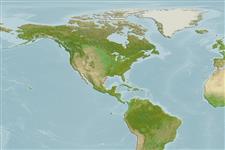>
Zeiformes (Dories) >
Zeniontidae (Armoreye dories)
Etymology: Zenion: Particle zen, derived from zao = to give life .
More on authors: Goode & Bean.
Environment: milieu / climate zone / depth range / distribution range
Ekologi
laut batidemersal; kisaran kedalaman 180 - 700 m (Ref. 74511). Deep-water; 44°N - 28°S, 98°W - 94°W
Western Indian Ocean: Tanzania and off Delagoa Bay, Mozambique. Western Central Pacific (Ref. 40499). Southeast Pacific: Nazca and Sala-y-Gomez (Ref. 50546). Western Atlantic: Antilles and Venezuela (Ref. 26340). Northwest Atlantic: Canada (Ref. 5951). Eastern Atlantic. South China Sea (Ref.74511).
Size / Weight / umur
Maturity: Lm ? range ? - ? cm
Max length : 15.6 cm TL jantan/; (Ref. 115012); Berat maksimum terpublikasi: 37.00 g (Ref. 115012)
deskripsi pendek
Morfologi | Morfometrik
Duri punggung (Keseluruhan (total)): 6 - 7; duri punggung lunak (Keseluruhan (total)): 25-28; Duri dubur 1; Sirip dubur lunak: 23 - 28. Body reddish in color (Ref. 4256).
Found over mud or sand-mud bottom (Ref. 26999). Reported to up to 700m depth (Ref. 89996).
Life cycle and mating behavior
Kematangan | Reproduksi, perkembang biakan | Pemijahan | telur-telur | Fecundity | Larva
Heemstra, P.C., 1986. Zeniontidae. p. 441. In M.M. Smith and P.C. Heemstra (eds.) Smiths' sea fishes. Springer-Verlag, Berlin. (Ref. 4256)
Status IUCN Red List (Ref. 130435)
ancaman kepada manusia
Harmless
penggunaan manusia
informasi lanjut
Umur / SaizPertumbuhanpanjang-beratpanjang-panjangukuran frekuensiMorfometrikMorfologiLarvaDinamika larvapemulihanKelimpahanBRUVS
AcuanBudidaya airprofil budidaya airStrainGenetikaElectrophoresesDiturunkanPenyakit-penyakitPengolahanNutrientsMass conversion
mitraGambarStamps, Coins Misc.Suara-suaraCiguateraKecepatanTipe renangArea insangOtolithsOtakPenglihatan / visi
Alat, peralatan
laporan khas
muat turun XML
Sumber internet
Estimates based on models
Preferred temperature (Ref.
123201): 10.3 - 12.8, mean 11.4 °C (based on 5 cells).
Phylogenetic diversity index (Ref.
82804): PD
50 = 0.5703 [Uniqueness, from 0.5 = low to 2.0 = high].
Bayesian length-weight: a=0.01230 (0.00468 - 0.03232), b=2.99 (2.77 - 3.21), in cm total length, based on LWR estimates for this (Sub)family-body shape (Ref.
93245).
Trophic level (Ref.
69278): 3.6 ±0.8 se; based on size and trophs of closest relatives
Fishing Vulnerability (Ref.
59153): Low vulnerability (10 of 100).
